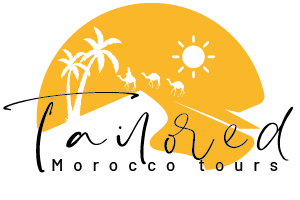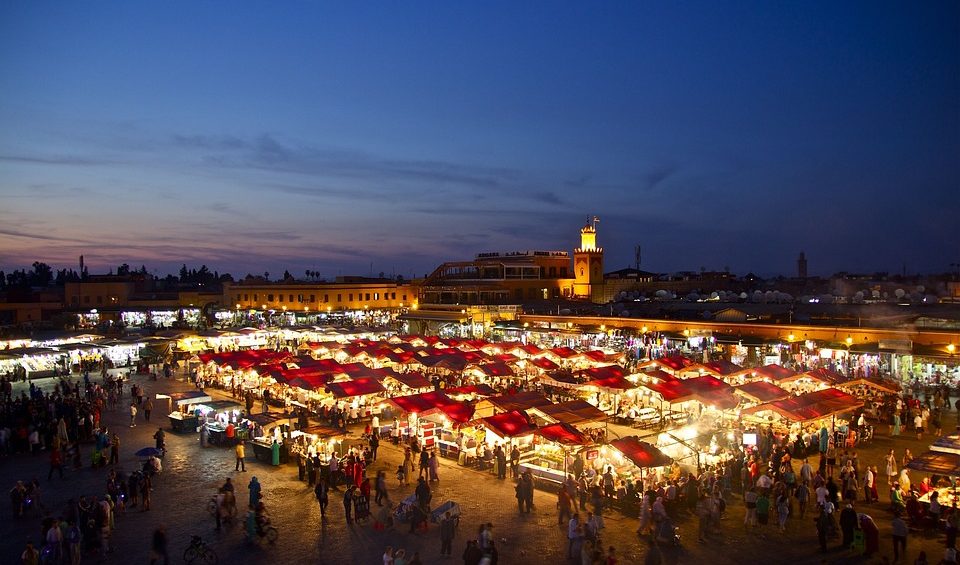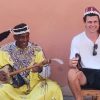The square Jemaa el-Fnaa is the central square of Marrakech and is bustling with activity. Street vendors sell dried figs and fresh juice, people play street games and monkeys roam around. Be sure to tip the entertainers. This is a popular area for tourists and locals alike. The ‘Jemaa el Fnaa’ is a lively place to spend an afternoon.
La Bahia Palace
The Bahia Palace is a mid to late-nineteenth-century palace in Marrakesh, Morocco. It was begun in 1859 by Si Musa, grand vizier to the Alaouite sultan Muhammad ibn Abd al-Rahman and later Sultan Moulay Abdelaziz.
The Bahia Palace is an impressive palatial complex with beautiful gardens that cover 8,000 square meters. The palace itself is not particularly large but is home to 160 rooms and is one of the most famous monuments in Morocco. The Bahia Palace is still used by the Moroccan royal family today.
The Bahia Palace features an intricate courtyard and white marble corridors. It was built in the late nineteenth century by Grand Vizier Bou Ahmed and was later used by the French. It contains over 150 rooms and was originally home to the vizier’s family, including four wives and 24 mistresses. However, the palace was converted to a royal residence during the French protectorate. Its architecture was a result of the French desire to maintain privacy for their ruling families.
This palace is an excellent place to relax and contemplate the art of the past. It is a time capsule of 19th-century morocco, with intricately painted mosaics and Italian white marble walls. Its massive courtyard is ideal for a relaxing stroll. It is also a more affordable option than other palace gardens in the city.
Jemaa el-Fnaa
If you’re looking for an authentic and traditional Marrakech meal, try the food at Jemaa el-Faa. This market is a maze of tunnels and stalls, and it’s easy to get lost and buy something you don’t need. Luckily, you can get lost in the market, but there are some tips that will help you get back on track.
Jemaa el-Faa is the heart of the medina, and it’s a hive of activity. The streets are packed with people, street vendors, and improvised dentists. There are also snake charmers, musicians, and acrobats. You can also get your hands and feet tattooed, or learn about traditional Moroccan stories from storytellers.
Jemaa el-Faa in Marrakech is the cultural center of the city. While the area is dangerous, it’s also an epic experience. If you get lost or confused, a helpful local will be more than happy to point you in the right direction. You can also find ATMs on the bigger streets around the square, and there are plenty of restaurants and makeshift food stands in the area. If you want to sit and relax in a cafe, a multi-story terrace offers a view of the city.
If you love people-watching, you’ll love the rooftop cafes that flank the square. A few good places to have a drink here include Cafe de Paris and Café du Grand Balcon. While the name is confusing, it essentially means “place of gathering” or “gathering” in Arabic. It’s interesting to note that the square was once a mosque of the Almoravid dynasty.
Bab er Robb
The Bab er Robb is the southern gate of Marrakech, Morocco. It is one of the most iconic sights in the city and is a must-see when visiting the city. Its ancient arches and ruins make it a stunning place to visit. This gate was used as a fortress by the Berbers and is now a popular tourist destination.
The gate is located in the historic medina of Marrakech, near the Bab Agnaou and Kasbah districts. It was once used to connect the city with the mountain towns of Asni and Amizmiz. However, today, it is only used for a few important events in the city, like weddings and funerals.
The Bab Er Robb is one of the 19 gates in Marrakech. It means Lord’s Gate in Arabic and serves as the main entrance into the Medina. Although not as visually stunning as the Bab Agnaou, it still provides a beautiful rose garden and comfortable benches for visitors.
There are several options for transportation to and from the Bab er Robb in Marrakech. Taxi Verts, Tangier Taxi, and Red Kech Travel are just a few of the companies that offer a trip to the Bab er Robb. Once you’ve chosen your transport mode, Moovit will help you find the best route and time to reach Bab er Robb.
Dar Si Said
Dar Si Said is a late nineteenth-century palace that has been converted into a museum. The collection of timeless artifacts highlights the central role of arts and crafts in Moroccan history. It is also home to an interior garden. Many Morocco group tours include a visit to this museum.
The museum’s highlight is the ancient stone basin, which is a masterpiece of Islamic art. It was carved from rock and originally stood in the Medersa Ben Youssef. It is an exceptional example of the anti-figurative art that adorned the Islamic world. Various motifs, including eagles and arabesques, are on display.
Dar Si Said was originally built in the nineteenth century by Said ben Moussa, a lawyer and Minister of War in the reign of Sultan Abdul-Aziz. He had a reputation for being a shrewd jurist, and in fact, the building became the seat of the Marrakech region during the French protectorate. Later, the General Administration of Fine Arts and Archeology took over the building and turned it into a museum and workshops for traditional crafts.
The Museum of Islamic Art is located next to the Riad Star. It is home to an incredible collection of artwork, including works by Majorelle and Delacroix. For those who are more active, booking a bike tour of the medina is an excellent way to explore the city. There are cycle lanes throughout the medina, which makes it possible to avoid heavy foot traffic.
House of Photography
If you are a keen photographer, you will definitely want to visit the House of Photography in Marrakech. It’s a small museum, but you’ll come away with some amazing photos. It’s also housed in a pretty building with a roof terrace that provides panoramic views of the Atlas mountains and the city’s rooftops. Entry is 50 dirhams.
This museum opened about 10 years ago and features an impressive private photographic collection that stretches from the 1870s to the 1950s. Its exhibits are a great way to learn more about Moroccan culture and history. There are photographs by famous photographers from the nineteenth century, as well as images of life in Morocco.
Visitors can enjoy a range of exhibits including the Moroccan Tribes exhibition, which spans three levels. On the top floor, you can enjoy a drink or a snack from the cafe. Admission is 50 mad, which includes a visit to the café. Throughout the museum, you’ll be surrounded by fascinating works of art, which will make your trip to Marrakech a truly memorable experience.
Marrakech’s House of Photography is located in a beautifully restored Riad near the Ali Ben Youssef Madrasa. The museum opened in 2009 and is a must-visit for photography and art lovers. Visitors to the museum should be prepared to spend a few hours viewing the displays. The Museum also has a roof terrace, which is a great place to sit and enjoy the city’s panoramic views.
Street food
Street food in Marrakech is a great way to sample Moroccan cuisine. You can find some delicious dishes at stalls scattered across the city and pay only a few dollars for them. Try the lamb brochettes which are super tender and packed with spices. These are usually served in small street-side kitchens that are equipped with a smoking barbecue. These make for great takeaway snacks. Another tasty dish that you can find in Marrakech is the Tagine. This is more of a cooking technique than a dish itself, but you’ll get to taste the incredible tenderness of the meat and vegetables.
Whether you prefer vegetarian or meat, you’ll be sure to find a dish to suit your tastes in Marrakech. Moroccans tend to eat from nose to tail, and their food is no different. Couscous is another delicious dish, made of semolina and topped with meat and vegetables. It’s light and zesty and contains plenty of spices such as cinnamon and turmeric.
Street food in Marrakech is not suitable for gluten-intolerant travelers, as bread is a staple. The main course of meals in Marrakech is accompanied by bread. During the nighttime, you can find street food vendors selling hefty sandwich pockets, filled with spicy tomato relish. You can also try a delicious lamb sausage called merguez, which is a traditional dish of northwest Africa.




